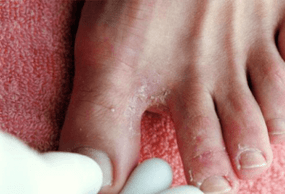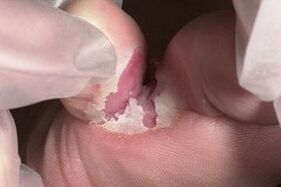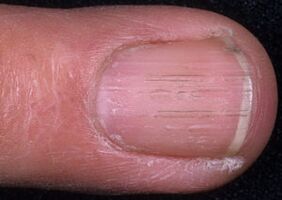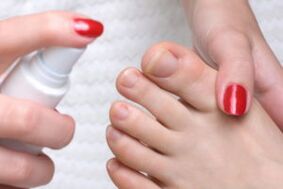Foot fungus is a skin disease characterized by active reproduction in the epidermis of certain types of fungi. Today, both elderly people and children with weakened immune systems are susceptible to this disease. Symptoms of a fungus in the legs depend on the type of pathogen of the infectious process and the size of the affected foot and nail plate, and there are certain differences that indicate the development of infection at different stages. You need to know how to recognize a fungus on your feet, which will allow you to start treatment on time and stop its further development.

Symptoms of the disease
The main place for the growth of fungus on the legs becomes the area between the toes. This pathology is accompanied by the appearance of symptoms such as burning of the epidermis, severe itching and redness. In addition, a person may observe cracked and flaky skin, as well as the formation of blisters on the feet and increased dryness of the dermis.
The same symptoms of fungus on the legs can occur on the heel and are accompanied by excessive keratinization of the skin. The insidiousness of such a disease is that during its course it is possible for a fungus to form on the feet, which is difficult to treat, and the wounds themselves are in a state of superinfection.
How to recognize fungus in the legs, and what symptoms can signal the onset of the disease? The first signs of the disease are the appearance of small scales, ie different types of crusts, from small pityriasis to large lamellae. There are different types of fungi that cause the disease, but they are all characterized by the same symptoms:

- In the early stages of development, the pathology continues without obvious symptoms. First, the interdigital folds are affected and most often occur between the third and fourth fingers.
- As the fungal disease progresses, the sides of the feet are affected, gradually spreading to the ankle.
- With a fungal infection of the feet, the skin becomes noticeably thicker, cracked and begins to glow.
- The skin becomes very dry and itchy. In addition, the epidermis becomes very red and its affected areas become inflamed.
- Patients begin to complain of pain and burning in the legs.
- As the disease progresses to an indifferent form, blisters begin to appear on the skin. When they are opened, the affected areas of the skin become very wet and soft.
There are several forms of foot fungus, and each of them is accompanied by the development of certain symptoms.
Forms of pathology
Experts identify the following types of fungi that can affect the skin of the feet:
- interdigital;
- hyperkeratotic (moccasins);
- dyshidrotic.
The most common form of interdigital fungus in the legs is interdigital, characterized by the appearance of certain symptoms:
- often the area of the fourth and fifth fingers becomes the site of localization of this fungal form.
- As the disease progresses, the skin acquires a characteristic scaly appearance and may crack severely;
- Between 3, 4 and 5, a weeping crack or funnel is formed, surrounded by scales of white or green dried skin.

Interdigital fungal skin lesions may be dry or wet. If wet interdigital fungus is found, the skin appears swollen. With a dry lesion of the epidermis, its peeling and shedding is noted.
The first sign of foot fungus, such as moccasins, is pain, the manifestation of which is observed in the foot. As the pathology progresses, there is a gradual thickening of the skin on the heel, which leads to the formation of cracks.
This form of fungal disease of the legs is considered the most difficult and indifferent, but it is easy to recognize. A fungal disease can manifest itself in the defeat of the nail plates, in which case they acquire a characteristic thickening, tend to collapse and may even fall off completely.
The vesicular form of the fungus is characterized by the formation of blisters with a clear liquid inside. Gradually, such blisters grow, become cloudy and clear, causing erosions of various sizes. The main localization of the bubbles becomes the area closer to the toes on the heel, but they can be scattered over the moccasins.
The vesicular form of a fungal disease is considered quite rare, but easier to treat. This is due to the fact that the vesicles become the site of localization of the pathogen, ie do not penetrate into the deeper layers of the skin. When a viral or fungal infection joins a vesicular fungal disease, serious skin lesions are observed and treatment is difficult.
Experts distinguish a deleted form of the fungus in the legs, where all the symptoms are blurred. The diagnosis of such a pathology is very problematic, because the affected skin looks like a simple untidy feet. In a patient with such a fungus on the foot, the symptoms are yellowing of the nails and peeling of the feet, but they are so mild that the patient does not pay attention to them.
The erased form of the fungus continues in waves, ie it becomes heavier in the hot season, and almost completely disappears in the winter. Any weakening of the immune system is accompanied by a sharp exacerbation of the disease, which makes it difficult to treat athlete's foot.
How to recognize onychomycosis?
Symptoms of nail fungus can vary significantly at different stages, indicating the development of an infection. How does nail fungus start and what symptoms should I look for?

- In the first stage, there are no characteristic symptoms of the lesion, and barely visible streaks and spots appear on the nail. If you ignore the first signs of the disease and start the fungus, it is possible that pus will accumulate in the area of the periungual plaques. The result of such a pathological process is gangrene or amputation of the lower extremities.
- With the second degree of fungal disease, the natural shine of the nails disappears. Gradually the nail changes color and white and brown streaks appear on it. Deformation of the upper part of the nail and its sides is possible. The advanced stage of bacterial damage to the nails is characterized by their increased fragility, delamination and cuticle inflammation. It continues to develop pathologically and spreads to other nails and feet.
- In the third stage of onychomycosis, the nail becomes yellow or dirty brown. In addition, it becomes very loose, thickens and lags behind the nail bed. Often, severe pain begins when wearing shoes, and itching of the skin simply becomes unbearable.
There are several types of fungal infections of the toenails, each of which causes certain symptoms.
- Hypertrophic onychomycosis is accompanied by thickening and yellowing of the nail. The nail is well divided and a thickened epidermis is visible underneath.
- Atrophic onychomycosis causes thinning and destruction of the nail, and keratinized skin appears under it.
- Onychomycosis, when affected by mold, often develops against the background of other pathologies, rather than as an independent disease.
The nail can be painted yellow, brown, green or black. Often a complication develops in the form of inflammation of the periungual bed with the release of pus.
Prevention of pathology

With the normal functioning of the immune system, it is unlikely that nail fungus will begin to develop after infection, because the body itself can cope with it. If a fungal infection still affects the feet and nails, effective treatment is needed. The sooner the fight against such a pathology begins, the higher the patient's chances of complete recovery.
Fighting foot fungus is a very laborious process, so it is easier to prevent the development of the disease. To do this, the following preventive measures should be taken:
- keep your feet dry;
- do not wear other people's shoes;
- choose socks made of cotton fabric;
- Do not run barefoot on the beach.
When the first signs of fungus appear on the legs, you should contact a specialist. It is important to identify the pathology at the very beginning of its development and prevent its further progression, which will help prevent many complications. You should consult a dermatologist to understand how to identify fungus on the legs.

























